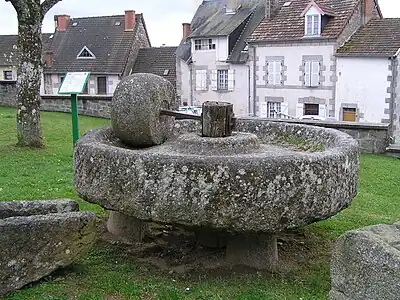Crocq
Crocq (French pronunciation: [kʁo]; Occitan: Cròc) is a commune in the Creuse department in the Nouvelle-Aquitaine region in central France.
Crocq | |
|---|---|
 The Chapel of the Visitation, in Crocq | |
.svg.png.webp) Coat of arms | |
Location of Crocq | |
 Crocq  Crocq | |
| Coordinates: 45°52′09″N 2°22′05″E | |
| Country | France |
| Region | Nouvelle-Aquitaine |
| Department | Creuse |
| Arrondissement | Aubusson |
| Canton | Auzances |
| Intercommunality | CC Marche et Combraille en Aquitaine |
| Government | |
| • Mayor (2020–2026) | Jean-Luc Pierron[1] |
| Area 1 | 14.16 km2 (5.47 sq mi) |
| Population | 404 |
| • Density | 29/km2 (74/sq mi) |
| Time zone | UTC+01:00 (CET) |
| • Summer (DST) | UTC+02:00 (CEST) |
| INSEE/Postal code | 23069 /23260 |
| Elevation | 640–829 m (2,100–2,720 ft) |
| 1 French Land Register data, which excludes lakes, ponds, glaciers > 1 km2 (0.386 sq mi or 247 acres) and river estuaries. | |
Geography
An area of lakes, streams and farming comprising the village and a couple of hamlets, some 13 miles (21 km) southeast of Aubusson at the junction of the D10, D28 and the D996 roads.
The Chavanon (locally called la Ramade) has its source in the southeastern part of the commune, near the hamlet le Montel-Guillaume.
The river Tardes forms all of the commune's northeastern boundary.
Population
| Year | Pop. | ±% |
|---|---|---|
| 1962 | 704 | — |
| 1968 | 746 | +6.0% |
| 1975 | 844 | +13.1% |
| 1982 | 834 | −1.2% |
| 1990 | 674 | −19.2% |
| 1999 | 546 | −19.0% |
| 2008 | 511 | −6.4% |
Sights

The castle

The oil-press
- The remaining towers of a twelfth-century castle.
- A thirteenth-century church of St. John at Montel-Guillaume.
- The nineteenth-century church of St. Eloi.
- The twelfth-century chapel of Notre-Dame.
- A dolmen in the forest.
- Several 16th- and 17th-century houses
- A racing car museum at Mas du Clos.
- A display of machines and tools once used in the fur factory.
See also
References
- "Répertoire national des élus: les maires" (in French). data.gouv.fr, Plateforme ouverte des données publiques françaises. 13 September 2022.
- "Populations légales 2020". The National Institute of Statistics and Economic Studies. 29 December 2022.
Wikimedia Commons has media related to Crocq.
This article is issued from Wikipedia. The text is licensed under Creative Commons - Attribution - Sharealike. Additional terms may apply for the media files.